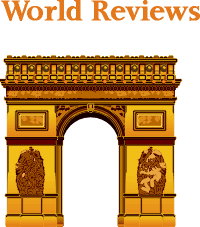

A global archive of independent reviews of everything happening from the beginning of the millennium
Read our Copyright Notice click here
For publication dates click here
The Library also has a sound collection
[1].
View through porthole
There was an acknowledged debt to
Hawksmoor
An exhibition for recorded sound
....
sponsored by Bowers and Wilkins
THE BRITISH LIBRARY
Reviewed by ANDRE BEAUMONT
The London precedent for a modernist internal space like that now found in the Design Museum was set by a design commenced forty-five years ago for the British Library by the modernist architect, Professor Sir Colin St John Wilson.
The British Library is a quintessential British institution with a modern attitude. Its interior modernism is still very fresh and it offers lovely interior spaces to walk around. For the exterior, 'Sandy' Wilson was partially influenced by his friend, Sir James Stirling, whose career evolved to make him the leading post-modernist architect in Britain. Wilson, though, remained firmly within the modernist canon especially for the interior, his skill at toplighting museum, library and study spaces having been well-honed elsewhere.
The exterior finishes were considered dull at the time but they have weathered the British weather incredibly well in contrast to, say, the Le Corbusier-inspired shuttered concrete used by an earlier generation of architects like Sir Denys Lasdun and Sir Basil Spence.
There is a lot of detail, like doors, designed by Wilson so he continued in a tradition set by Adam, Mackintosh and Frank Lloyd Wright in designing the detail down to the door furniture. At the time I wrote a piece about the library I had just spent £30,000 on a pair of hardwood external doors I had designed for Farringdon Station and he was not surprised at the cost, though I was.
Architecture can be about light, both external modelling of it by buildings and in interiors, and he used it better than anyone I knew. Look at external light levels and how much has been brought in.
Scarcely .... but I had done some work on St.Pancras behind!
The exterior led it to be likened to an academy for secret policemen, a felicitous turn of phrase, but construction proved the point of those roofs with breaks in them - to let light in.